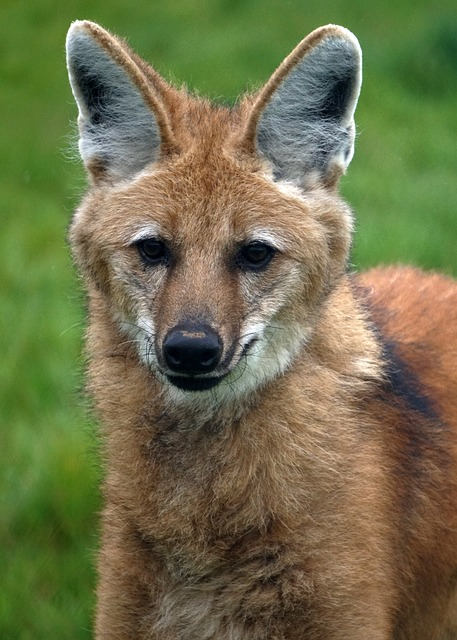Maned wolf or chrysocyon brachyurus is the largest canid in South America. These wild canids also live in Northern Argentina, South and Central Brazil, Paraguay, Bolivia, and Southern Peru.

It is a distinct species of gray wolf. Standing nearly 3 feet tall at the shoulder, these wild animals weigh around 50 pounds.
The reddish-brown fur on their back is tipped with black, giving them a mane-like appearance – hence their name. They are also known as ‘skunk wolves’ due to their distinctive smell and coat coloration.
Despite their size, they are incredibly shy and elusive animals that are rarely seen in the wild
Maned Wolf – Characteristics and Conservation Status
Maned Wolf Size
The maned wolf is a large canine native to South and Central America. It has reddish-brown fur, long ears, and a distinctive black mane running along its back. Though it resembles a small gray wolf, the maned wolf is not related to any wolf species.
It stands at about 3 feet tall and weighs roughly 50 pounds, making it the largest wild canine in South America. In comparison, a gray wolf measures around 32-37 inches at the shoulder and weighs between 40 and 145 pounds depending on the subspecies.
As such, the maned wolf is significantly larger than its closest relatives like coyotes and foxes. Despite their size, maned wolves are relatively shy and timid animals.
Maned Wolf Diet
Maned wolves are the largest canid species in South America, sometimes referred to as “fox on stilts” due to their long legs and reddish fur.
Even though they look similar to a gray wolf, maned wolf’s diet depends on different range of habitats.
They mainly hunt for small mammals, such as armadillos and rodents, as well as birds, reptiles, and amphibians. Additionally, they also eat fruits like pear and bananas to supplement their diet.
Maned wolves may even feed on carrion if they can not find food. Additionally, the captive maned wolves’ diet is often supplemented with commercial dog food and raw meat.
Maned Wolf Reproduction & Habitat
The maned wolf is the tallest species of wild dog, with a unique gray wolf-like appearance and long reddish fur. Its native habitat includes the open grasslands, scrub, and savannas of South America.
Breeding season starts in April and remains till June, with a gestation period of around 65 days. Pups are born in a litter of 1-6 pups who can not see or hear properly for the first 2 weeks of life before they open their eyes.
Maned Wolf Behaviour
The Maned wolf is nocturnal, meaning it is more active in the nighttime. They rest in the daytime under dense forests and hunt in the nighttime till dawn.
With this, maned wolves live alone and not in packs like wolves. Wild-maned wolves are shy animals and only attack humans when they feel danger or threatened from them.
Conservation Status
The maned wolves are threatened species due to their habitat destruction caused by agricultural development. The habitat fragmentation, destruction of pasture, and overgrazing by livestock reduce their food resources and territory.
Farmers also killed maned wolves when they found out them attacking their livestock. Presently there are 2200 to 4500 maned wolves.
The IUCN Red List of Endangered Species currently categorizes them as Near Threatened due to their dwindling numbers.
Additionally, the Smithsonian National Zoo Park has been working to protect maned wolves for nearly 30 years and coordinates the collaborative, interzoo maned wolf Species Survival Plan of North America, which includes breeding maned wolves, studying them in the wild, protecting their habitat, and educating people about them.
Falkland Islands Wolf
The Falkland Islands Wolf, scientifically known as Dusicyon australis, is an extinct species of wolf. It was the only native land mammal in the Falkland Islands and also the only extant species in the genus Dusicyon.
This wolf became extinct in 1876 due to hunting by settlers, who believed that it posed a threat to their livestock.
Outro
A maned wolf is around 50 pounds and 3 feet tall at the shoulder. These wild canids are omnivorous animals that eat fruits, meat, and even carrions in scarcity. Moreover, they are highly active at nighttime, as they have to hunt.
Additionally, they are marked as the near threatened species by the IUNC, and conservation efforts are given continuously for restoring this species. Check out the video below to explore more about the maned wolf.
Frequently Asked Questions
Are maned wolves the tallest?
A maned wolf is the tallest canid.
Is a maned wolf taller than a Great Dane?
It 3 feet long, and it is taller than some great Danes.
Are maned wolves taller than wolves?
Maned wolves are only 3 inches taller than gray wolves.
Are maned wolves faster than wolves?
Maned wolves are faster than other wolves and canines.








